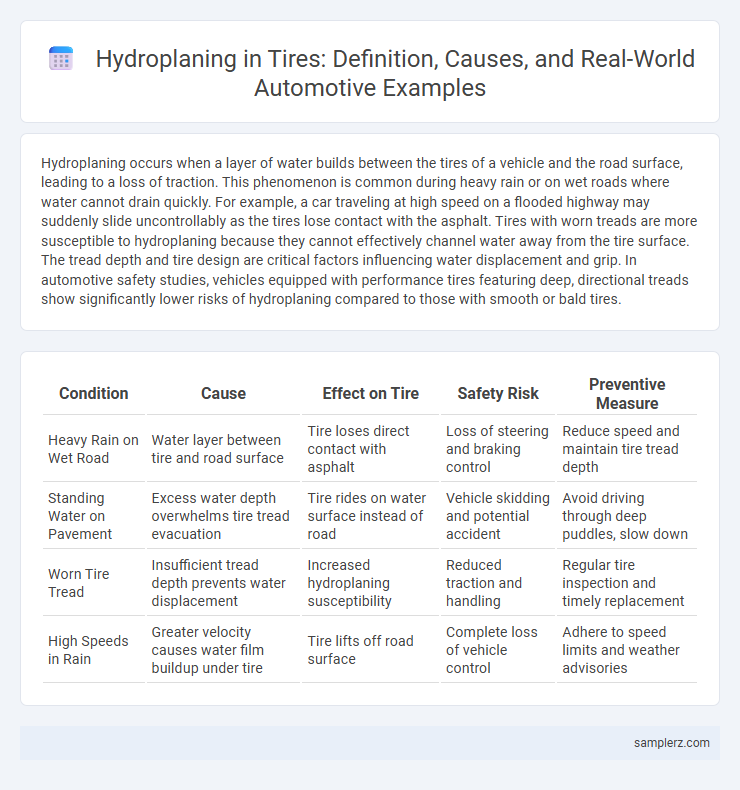Hydroplaning occurs when a layer of water builds between the tires of a vehicle and the road surface, leading to a loss of traction. This phenomenon is common during heavy rain or on wet roads where water cannot drain quickly. For example, a car traveling at high speed on a flooded highway may suddenly slide uncontrollably as the tires lose contact with the asphalt. Tires with worn treads are more susceptible to hydroplaning because they cannot effectively channel water away from the tire surface. The tread depth and tire design are critical factors influencing water displacement and grip. In automotive safety studies, vehicles equipped with performance tires featuring deep, directional treads show significantly lower risks of hydroplaning compared to those with smooth or bald tires.
Table of Comparison
| Condition | Cause | Effect on Tire | Safety Risk | Preventive Measure |
|---|---|---|---|---|
| Heavy Rain on Wet Road | Water layer between tire and road surface | Tire loses direct contact with asphalt | Loss of steering and braking control | Reduce speed and maintain tire tread depth |
| Standing Water on Pavement | Excess water depth overwhelms tire tread evacuation | Tire rides on water surface instead of road | Vehicle skidding and potential accident | Avoid driving through deep puddles, slow down |
| Worn Tire Tread | Insufficient tread depth prevents water displacement | Increased hydroplaning susceptibility | Reduced traction and handling | Regular tire inspection and timely replacement |
| High Speeds in Rain | Greater velocity causes water film buildup under tire | Tire lifts off road surface | Complete loss of vehicle control | Adhere to speed limits and weather advisories |
Understanding Hydroplaning in Automotive Tires
Hydroplaning occurs when a vehicle's tires lose contact with the road surface due to a layer of water, causing a loss of traction and control. Factors influencing hydroplaning include tire tread depth, water depth on the roadway, vehicle speed, and tire pressure. Modern tire designs with deep grooves and channels help disperse water, reducing the risk of hydroplaning and enhancing automotive safety.
Common Causes of Hydroplaning on Roads
Hydroplaning occurs when a vehicle's tires lose contact with the road surface due to a layer of water, often caused by heavy rain, standing water, or poor drainage systems on highways and urban roads. Worn tire treads and improper tire pressure significantly increase the risk, reducing the tire's ability to channel water away. Road conditions such as uneven pavement, oil residues, and debris further exacerbate hydroplaning by decreasing tire traction and increasing water buildup.
Real-World Examples of Tire Hydroplaning
Hydroplaning occurs when a vehicle tire loses contact with the road surface due to water buildup, reducing traction and control. Real-world examples include sudden tire skid incidents on wet highways, particularly during heavy rainstorms or after driving through standing water on speedways. Low tread depth and high speeds exacerbate hydroplaning risks, often resulting in dangerous loss-of-control accidents on urban and rural roads.
Impact of Tread Depth on Hydroplaning Risk
Tread depth significantly impacts hydroplaning risk, as deeper grooves effectively channel water away from the tire surface, maintaining traction on wet roads. Tires with worn tread below 2/32 inch lose this ability, increasing the likelihood of hydroplaning and reducing vehicle control. Maintaining adequate tread depth is crucial for preventing water buildup beneath the tire and ensuring safe driving conditions during rainfall.
Hydroplaning During Heavy Rain: Case Studies
Hydroplaning during heavy rain occurs when a vehicle's tires lose contact with the road due to a layer of water, reducing traction and control. Notable case studies, such as the 2020 highway incident in Florida, illustrate how tire tread depth below 2/32 inch significantly increases hydroplaning risk, affecting braking distance and steering response. Research from the National Highway Traffic Safety Administration (NHTSA) emphasizes the importance of maintaining adequate tire pressure and tread patterns designed for effective water evacuation to mitigate hydroplaning hazards.
Vehicle Speed and Its Role in Hydroplaning Incidents
Vehicle speed significantly affects the likelihood of hydroplaning, as higher speeds reduce tire traction by preventing water displacement beneath the tire tread. At speeds above 35 mph, the risk of hydroplaning increases exponentially, especially on wet roads with standing water. Understanding the critical speed thresholds for various tire types and tread depths is essential for improving vehicle safety and preventing hydroplaning incidents.
Tire Design Features that Prevent Hydroplaning
Specialized tire tread patterns with deep circumferential grooves rapidly channel water away from the contact patch, reducing the risk of hydroplaning. Advanced siping technology enhances water dispersion by creating additional biting edges that maintain road grip on wet surfaces. Tires constructed with optimized rubber compounds improve wet traction, ensuring better adherence and safety in hydroplaning-prone conditions.
The Dangers of Improper Tire Inflation and Hydroplaning
Improper tire inflation significantly increases the risk of hydroplaning by reducing tire contact with the road surface, leading to loss of traction and vehicle control during wet conditions. Underinflated tires cause uneven tread wear, decreasing water displacement efficiency and escalating the likelihood of slipping on wet roads. Maintaining correct tire pressure ensures optimal tread performance and stability, reducing hydroplaning dangers and enhancing overall driving safety.
How Road Surface Conditions Affect Hydroplaning
Hydroplaning occurs when tires lose contact with the road surface due to a layer of water, significantly influenced by road texture and material. Smooth or worn asphalt surfaces increase the risk as they reduce water drainage, allowing water to accumulate and lift the tire. Grooved or porous surfaces improve water dispersion, minimizing hydroplaning by maintaining tire traction and contact with the road.
Preventive Measures to Avoid Tire Hydroplaning
Maintaining adequate tire tread depth of at least 4/32 inches significantly reduces the risk of hydroplaning by improving water channeling on wet surfaces. Regularly checking and adjusting tire pressure to the manufacturer's recommended levels enhances road contact and stability during rainy conditions. Reducing vehicle speed in heavy rainfall ensures the tires can effectively displace water, preventing loss of traction on wet roads.

example of hydroplaning in tire Infographic
 samplerz.com
samplerz.com